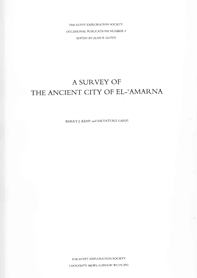
Amarna is an extensive Egyptian archaeological site that represents the remains of the capital city newly established (1346 BC) and built by the Pharaoh Akhenaten of the late Eighteenth Dynasty, and abandoned shortly after his death (1332 BC). The name for the city employed by the ancient Egyptians is written as Akhetaten (or Akhetaton—transliterations vary) in English transliteration. Akhetaten means "Horizon of the Aten". The area is located on the east bank of the Nile River in the modern Egyptian province of Minya, some 58 km (36 mi) south of the city of al-Minya, 312 km (194 mi) south of the Egyptian capital Cairo and 402 km (250 mi) north of Luxor. The name Amarna comes from the Beni Amran tribe that lived in the region and founded a few settlements.
The area of the city was effectively a virgin site, and it was in this city that the Akhetaten described as the Aten's "seat of the First Occasion, which he had made for himself that he might rest in it".
It may be that the Royal Wadi's resemblance to the hieroglyph for horizon showed that this was the place to found the city. The city was built as the new capital of the Pharaoh Akhenaten, dedicated to his new religion of worship to the Aten. Construction started in or around Year 5 of his reign (1346 BC) and was probably completed by Year 9 (1341 BC), although it became the capital city two years earlier. To speed up construction of the city most of the buildings were constructed out of mudbrick, and white washed. The most important buildings were faced with local stone.It is the only ancient Egyptian city which preserves great details of its internal plan, in large part because the city was abandoned after the death of Akhenaten, when Akhenaten's son, King Tutankhamun, decided to leave the city and return to his birthplace in Thebes (modern Luxor). The city seems to have remained active for a decade or so after his death, and a shrine to Horemheb indicates that it was at least partially occupied at the beginning of his reign, if only as a source for building material elsewhere. Once it was abandoned, it remained uninhabited until Roman settlement began along the edge of the Nile. However, due to the unique circumstances of its creation and abandonment, it is questionable how representative of ancient Egyptian cities it actually is. Amarna was hastily constructed and covered an area of approximately 8 miles (13 km) of territory on the east bank of the Nile River; on the west bank, land was set aside to provide crops for the city's population. The entire city was encircled with a total of 14 boundary stelae detailing Akhenaten's conditions for the establishment of this new capital city of Egypt.
Most of the important ceremonial and administrative buildings were located in the central city. Here the Great Temple of the Aten and the Small Aten Temple were used for religious functions and between these the Great Royal Palace and Royal Residence were the ceremonial residence of the King and Royal Family, and were linked by a bridge or ramp. Located behind the Royal Residence was the Bureau of Correspondence of Pharaoh, where the Amarna Letters were found.
While the reforms of Akhenaten are generally believed to have been oriented towards a sort of monotheism, or perhaps more accurately, monolatrism. Archaeological evidence shows other deities were also revered, even at the centre of the Aten cult – if not officially, then at least by the people who lived and worked there. at Akhetaten itself, recent excavation by Barry J. Kemp has shown the presence of objects that depict gods, goddesses and symbols that belong to the traditional field of personal belief. So many examples of Bes, the grotesque dwarf figure who warded off evil spirits, have been found, as well as of the goddess-monster, Taweret, part crocodile, part hippopotamus, who was associated with childbirth. Also in the royal workmen’s village at Akhetaten, stelae dedicated to Isis and Shed have been discovered.

